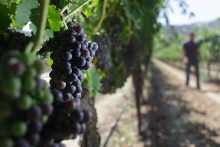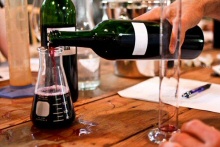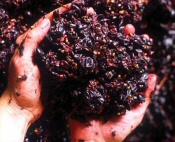|
 Petite Sirah is an intriguing varietal, beginning with its name. To start with, it's not small or Syrah, as the name would suggest. If anyone ever tells you that Petite Sirah is a toned-down version of a Syrah wine, they are wrong on so many levels. American wineries will often label wines as Petite Syrah, but this is all marketing to catch the attention of potential consumers who will recognize the "Syrah" name. To add even more confusion to the mix, the varietal's real name is not even Petite Sirah…it's "Durif." What? It's confusing, so let's explain. Petite Sirah is an intriguing varietal, beginning with its name. To start with, it's not small or Syrah, as the name would suggest. If anyone ever tells you that Petite Sirah is a toned-down version of a Syrah wine, they are wrong on so many levels. American wineries will often label wines as Petite Syrah, but this is all marketing to catch the attention of potential consumers who will recognize the "Syrah" name. To add even more confusion to the mix, the varietal's real name is not even Petite Sirah…it's "Durif." What? It's confusing, so let's explain.
The varietal is originally from France, named after a botanist, François Durif, who created it by cross-pollinating a varietal named Peloursin with Syrah in the Rhône-Alpes region of southeast France around the year 1860. So while it is related to Syrah, it's not Syrah. And while it's not included as a traditional Rhône varietal in France, it is considered by the U.S. Rhone Ranger group to be one.
The name "petite" refers to the varietal's small berries on the vine, yet the vine itself is regarded as one of the more vigorous vines requiring extensive canopy management. An example of this would be trimming down the vine's leaves to expose the fruit to more sunlight.
When it comes time to make wine from the grapes, the small berries result in a high skin-to-juice ratio, which ends up producing highly tannic wines. (Big red flag warning here: if you or anyone you know are not fans of big, tannic wines —steer clear of Petite Sirah wines!)
 As with many varietals, Durif colonized the far reaches of the world after originating in Europe. It's now primarily grown in California, France, Australia, and Israel. Although, based on its growing popularity as a varietal wine and the overall relative hardiness of the vine, it's quickly being planted in places such as Washington, Maryland, Arizona, Chile, Mexico, and Canada. As with many varietals, Durif colonized the far reaches of the world after originating in Europe. It's now primarily grown in California, France, Australia, and Israel. Although, based on its growing popularity as a varietal wine and the overall relative hardiness of the vine, it's quickly being planted in places such as Washington, Maryland, Arizona, Chile, Mexico, and Canada.
Here in our own beautiful state, Durif is planted extensively in Monterey, Lake, Sonoma, Napa, Mendocino, and San Joaquin counties. Within our Monterey wineries, Scheid and Pierce Ranch consistently put out some outstanding BIG Petite Sirah wines. Other local wineries will offer specific vintages of Petite Sirah wines, and the varietal is actually present in more red blend wines than you would think.
Not only is it popular to use for big red blends, including for numerous Monterey County wines (ask your server about the varietals in the blend you try on your next visit), but it's also used by winemakers in small quantities to fortify varietal wines from Pinot Noir to Cabernet Sauvignon to Zinfandel during non-ideal growing years. You'll rarely see this in a specific wine's tasting notes, and pretty much never will on the back of a bottle. With these minimum quantities (less than 25%) there is no requirement to list other grapes used in a varietal wine. Just know that even if you don't see Petite Sirah often, it's still there in a lot of Californian wines.
We've referenced "big" a couple of times now associated with this varietal, despite the size of it grapes. The big we're referring to is the wine produced with this varietal, especially varietal wines (75% or more of just Petite Sirah fruit). Some people find these wines very appealing, others not as much. It's because Petite Sirah wines are normally red wines which will knock your socks off…no joke. These are not just red wines for red wines lovers, these are red wines for meaty, juicy, dark, overflowing-body, take entire control of your olfactory senses red wine lovers.
 Petite Sirah is used as a popular blending varietal for specific desired characteristics. Petite Sirah wine produces dark, inky, deep purple wines, normally with high acid, alcohol, and tannin levels. Typical bouquet characteristics include herbal and black pepper overtones, with plumes and blueberries providing the punctuation notes for the aroma. Compared to Syrah, Petite Sirah wines are darker and tend to be fruitier. The brightness of these wines would initially cause one to think that they are meant to be opened young; however, thanks to the high tannin levels, Petite Sirah wines can easily age gracefully for 10 to 20 years. Petite Sirah is used as a popular blending varietal for specific desired characteristics. Petite Sirah wine produces dark, inky, deep purple wines, normally with high acid, alcohol, and tannin levels. Typical bouquet characteristics include herbal and black pepper overtones, with plumes and blueberries providing the punctuation notes for the aroma. Compared to Syrah, Petite Sirah wines are darker and tend to be fruitier. The brightness of these wines would initially cause one to think that they are meant to be opened young; however, thanks to the high tannin levels, Petite Sirah wines can easily age gracefully for 10 to 20 years.
Petite Sirah may not be everyone's favorite, even for the typical red wine connoisseur, but the varietal is undoubtedly going to continue to grow in popularity and it will continue to not be petite and not be Syrah. And if you're looking for a bottle to open on a chilly winter eve, look no further than a bottle of Petite Sirah. The boldness of the wine will surely warm you up!
|